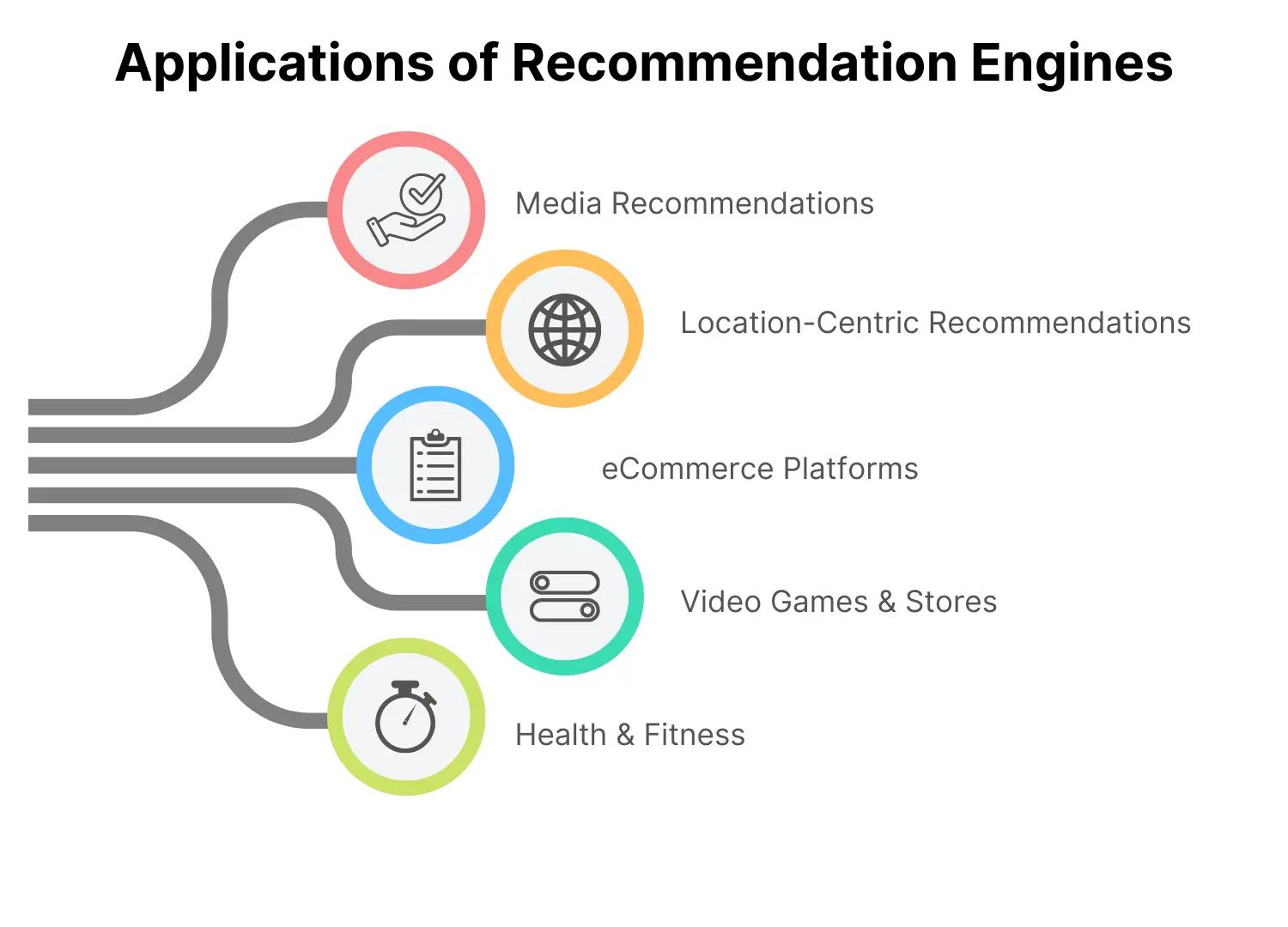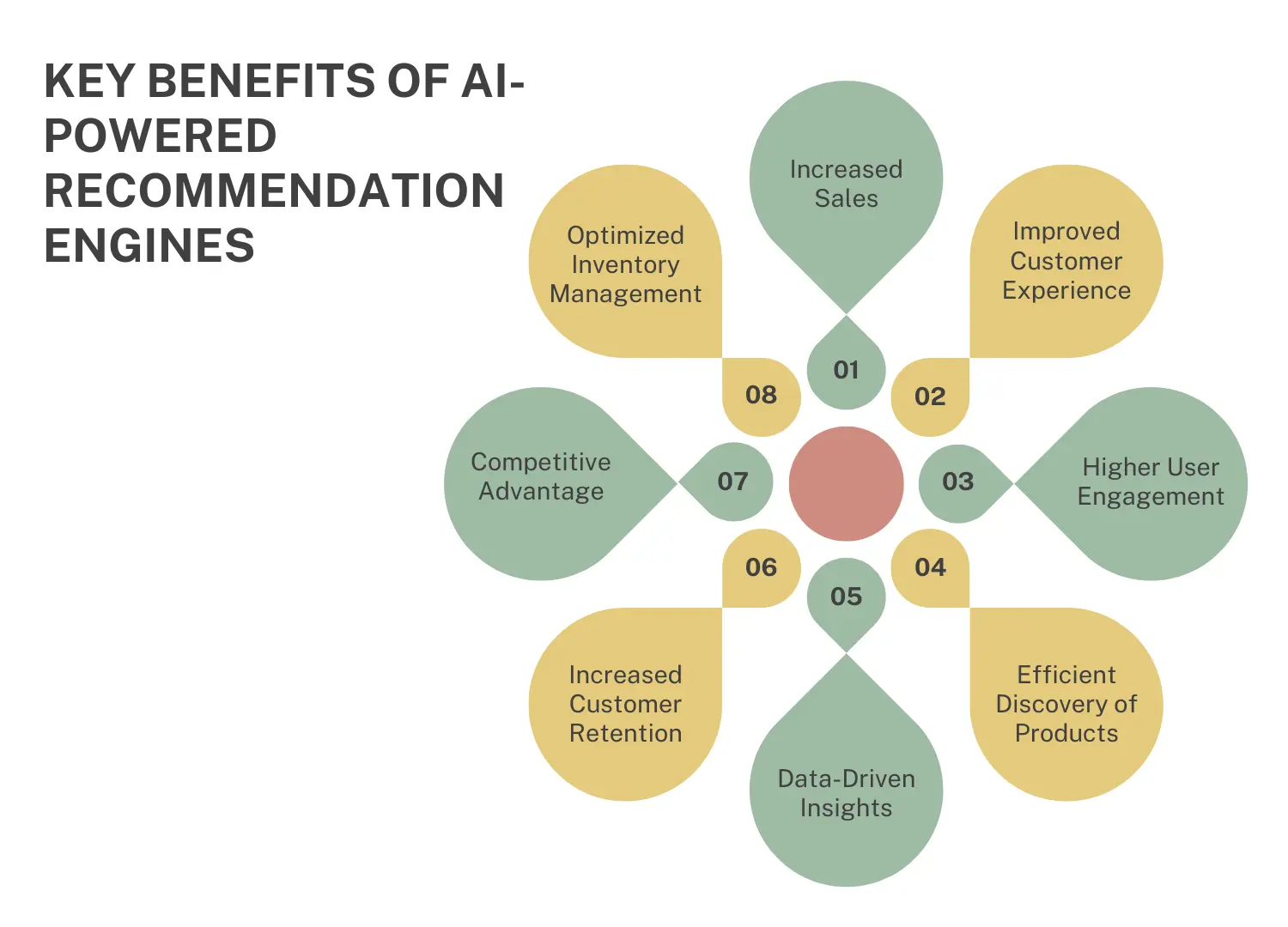Table of Contents
A recommender is also known as a recommendation engine. It is a type of artificial intelligence system that makes suggestions to a user. To identify trends in user activity data and suggest pertinent things based on those patterns, AI-based recommendation engines use machine learning (ML) algorithms and predictive analytics solutions.
What are recommendation engines? Users who might not have found certain items, services, or content on their own are assisted by recommendation systems. For many online businesses, including e-commerce websites, media streaming platforms, search engines, and social media networks, these systems are essential to driving traffic and building community. A recommender makes recommendations for what to view or watch next—for example, the next movie or video, a song to listen to, or a product that goes well with a particular order.
Recommendation systems’ given suggestions are also essential for tailoring user experiences. Personalization can increase sales by 5% to 15%, according to a study conducted by management consulting company McKinsey]. Furthermore, when they do not receive personalized encounters, 76% of customers express frustration. Recommendation systems are increasingly becoming popular. The market for recommendation engines is expected to reach USD 6.88 billion in 2024, and it is expected to triple in size in the next five years.
How do recommendation engines operate?
AI-based recommendation engines combine data science and machine learning services to provide users with relevant recommendations. To determine which recommendations are the most accurate, recommenders usually go through five stages:
1. Data collection
Since data forms the basis of a recommendation system, gathering data is an essential initial step. Explicit and implicit data are the two main categories of information that need to be collected.
User actions and activities, including comments, likes, ratings, and reviews, are included in explicit data. User activity, including past purchases, clicks, browsing and shopping cart activities, and search history, is included in implicit data.
In addition, recommenders employ feature data (like price range or item kind) to identify relevant products or services and additional customer data (like age or gender) and psychographics (like interests or lifestyle) to identify customers who are similar to them.
2. Retention
The next stage after gathering data is storing it. The sorts of data gathered determine the type of storage system. Data lakes are capable of holding both structured and unstructured data. Whereas, data warehouses combine data from many sources for machine learning and data analysis.
The best features of both data lakes and data warehouses are combined into one data management solution by creating a data lakehouse.
3. Examining
In the analysis stage, data sets are processed and examined using machine learning recommendations. The recommendation engine algorithm finds correlations, finds patterns, and evaluates the strength of the correlations and patterns. Large data sets can be used to train machine learning models so they can provide appropriate recommendations.
4. Refinement
Filtering the data to display the most pertinent things from the earlier analysis stage is the last step. Recommendation engine type-specific mathematical rules and formulae are applied to the data during the data filtering process.
5. Precision
To continuously evaluate a recommendation system’s outputs and improve the model to raise its accuracy and quality, an extra refinement step might be included.
Interested in Building a Recommendation System Too Support Your Business?
Types of Recommendation Engines
Different recommenders employ different methods of filtering. Recommendation engines often fall into three categories:
1. Collaborative filtering
Suggestions are filtered via a recommendation engine collaborative filtering method according to how similar a certain user is to other users. Using both explicit and implicit data, collaborative recommender systems assume that consumers with similar tastes will probably be interested in the same products and may even engage with them in similar ways down the road.
For example, Spotify employs collaborative filtering for its music material, while Amazon uses it for purchase recommendations.
Recommenders using collaborative filtering algorithms are capable of making insightful recommendations and typically don’t require thorough item descriptions. The cold start issue, which arises when the system has little past data to draw from, particularly for new users, can also affect collaborative filtering. Memory-based and model-based collaborative filtering systems are the two primary types.
Based on memory
Users and things are represented as a matrix in memory-based systems. Because they seek to locate their “nearest neighbors,” which may be comparable persons or objects, they are an extension of the k-nearest neighbors (KNN) algorithm. Two further categories further distinguish memory-based systems:
- Similarities between a specific user and every other user in the matrix are calculated by user-based filtering. The user-item matrix’s rows are compared using user-based similarity functions.
- Item-based filtering uses user behavior—that is, how users interact with items rather than item features—to calculate item similarity. In the user-item matrix, item-based similarity functions are computed between columns.
Model-driven
On the other hand, model-based systems use the data to build predictive machine learning solutions. The training data set for the model is the user-item matrix. Based on this, the model generates predictions for missing values or objects that the user has not yet discovered but are recommended. Matrix factorization is one of the most widely used model-based collaborative filtering algorithms. By using this dimensionality reduction technique, the frequently huge user-item matrix is divided into two smaller matrices with a limited number of dimensions: one for users and another for items. To anticipate the missing values (or the recommendations) in the bigger matrix, the two matrices are then multiplied together.
Deep learning neural networks are used in a more sophisticated matrix factorization method. Machine learning methods like Bayes classifiers, clustering, and decision trees are used by other model-based systems.
2. Content-Based Filtering
Recommendations are filtered using a content-based filtering mechanism according to an item’s features. Recommender systems that rely on content believe that a user who likes one item would likely enjoy another that is similar. Content-based filtering takes into account both explicit and implicit data, as well as item descriptions supplied by keywords and tags, such as color, category, and price.
Users and objects are represented as vectors in a vector space by the content recommendation engine. The similarity of objects is measured by one another. Two vectors are deemed more similar the closer they are to one another in space. The user will be recommended vectors based on features that are comparable to those of earlier items.
Regression models or user-based classifiers are used by content-based recommenders. The model uses the attributes and descriptions of products that a user is interested in as training data to produce recommendations for other things.
Natural language processing tags can be used to further enhance content recommendation platforms. However, for large amounts of data, this labeling procedure can be time-consuming.
Since content-based filtering is based on metadata features rather than previous user participation, it is less problematic about the cold start issue than collaborative filtering. However, since content-based filtering frequently recommends products that are similar to what people have already loved, it might be difficult to discover new stuff.
3. Hybrid recommendation systems
A hybrid recommendation system combines content-based and collaborative filtering, as the name suggests. Therefore, a hybrid technique can significantly improve a recommendation engine’s performance, but it needs sophisticated structures and a lot of processing power. For movie and TV program recommendations, Netflix, for example, uses a hybrid recommendation system.

The Advantages of Utilizing Recommendation Engines
A recommendation engine can benefit users as well as businesses. The following are some benefits that businesses can obtain by putting money into recommendation systems:
Enhanced usability
Making the appropriate product or service recommendation saves users the time-consuming task of endlessly browsing a large inventory. On Netflix, for example, recommendation algorithms are responsible for 80% of the content that users see. Moreover, tailored experiences result from personalized recommendation systems that are pertinent.
Increased client retention
A better customer experience is associated with a 20% increase in customer satisfaction, according to McKinsey research. Customers who are happy with a brand are more likely to be engaged and loyal, which helps businesses gain and hold onto more customers.
Higher conversion rates for customers
Using personalized recommendation systems encourages visitors to look at and click on more products, which may eventually lead to readers becoming buyers. More satisfying and tailored customer experiences resulted in a 10%–15% increase in sales conversion rates, according to McKinsey.
An increase in income
Revenue is generated by sales, which are driven by customer conversions. According to McKinsey, personalized product recommendations account for 35% of what customers purchase on Amazon. In the meanwhile, Netflix projects that their recommender system will save the company over $1 billion.
Revolutionize Your Business With AI-Powered Recommendations
Examples of Effective Recommendation Engines to Consider
The reputation of the most recognizable companies is due to their ability to comprehend their target market. They provide them with the best possible product offerings. How often do you hear someone refer to their startup as “the Netflix of…”? This phrase describes Netflix’s remarkable capacity to deduce customer preferences and deliver a customized experience on a large scale. The following companies are renowned for having strong AI-based recommendation engines:
Amazon
Amazon’s recommendation engine, which is frequently praised as being the best in its class, examines a wide range of data, including previous purchases, browsing history, ratings and reviews, and interactions with other Amazon services (like Amazon Prime). A staggering 35 percent of Amazon purchases are the consequence of recommendations.
Personalized choices such as “Keep shopping for” (recently viewed items), “Deals based on your recent history” (products similar to those recently viewed), and “Buy again” (previous purchases) are available to users on Amazon’s homepage.
Additionally, product pages with personalized suggestions show clients other products that they usually purchase together and again at the point of checkout. To continuously enhance and update its algorithms, the AI-based recommendation engine also makes use of user input via reviews and ratings.
Netflix
With more than 17,000 items in its library, Netflix’s product suggestion engine is both a convenience and a need.
75% of Netflix content is influenced by recommendations, according to the streaming behemoth. Netflix’s algorithm makes content-based filtering based on how users interact with other Netflix features (such as the “Continue Watching” list and the “Recently Watched” row), as well as their watching history and movie and TV program ratings.
Additionally, Netflix creates cohorts of similar users based on their geography and behavior. A user may get suggestions for highly rated titles in their area, for instance. The streaming service also takes into account variables like the duration of your viewing, the device you’re using, and the time of day.
The Best Buy
Best Buy, an electronics shop, almost went out of business in 2015. This was due to intense competition from Amazon. However, in 2015, the company brought in an AI-based recommendation engine to increase its online sales. Best Buy developed a recommendation system that takes advantage of both online and offline personalization by using its shop footprint.
Customers can view product recommendations, promotions that are exclusive to that store, and which items are available for pickup in-store when they visit a store and open the Best Buy app. Additionally, geolocation is used by the Best Buy website to assist users in finding nearby stores where they may physically view products.
A customer’s browsing history, previous purchases, and interactions with other Best Buy services (such as the “Wish List” feature and the “My Best Buy” program) are all examined by the recommendation engine algorithm.
Features of E-Commerce Recommendation Engines to Improve Your Online Store
A recommendation engine streamlines the user experience and increases the discoverability of products. They spare clients the headache of having to go through a huge product catalog and apply intricate search filters to discover what they need. Online retailers also gain from more sales and more devoted customers.
- Make the purchasing experience unique.
- Retailers employ personalization tools to enable customers to easily:
- Browse the products in the store.
- Obtain suggestions on pertinent products.
- View messages catered to their requirements.
Recommendation engines leverage past purchases and browsing patterns to select products that are relevant to the user’s purpose. Product listings are also geo-specific, displaying prices in the customer’s local currency plus any relevant shipping costs. With time, machine learning recommendations that are trained on behavioral data will present recommendations that are more and more pertinent.
Customization is beneficial, especially for mobile purchases. Users will opt for businesses whose websites or apps personalize content based on the user’s location. Personalized recommendation systems in e-commerce have the potential to streamline the user experience. Help customers find the products they require, and motivate them to explore more product categories.
Boost cross-selling and upselling
Recommendations for products offer a logical chance to upsell and cross-sell the client. It raises the average order value. Upselling is the practice of suggesting a more expensive or superior version of a product. Targeting a consumer who is looking at it or has already bought it.
For instance, your recommendation systems might provide recommendations for items with more processing power if they’re interested in an entry-level laptop. By presenting possibilities to users that they might not have otherwise thought about, recommendation engines increase the discoverability of products.
Cross-selling is the practice of persuading consumers to buy similar or complementary goods, such as a Bluetooth headset to match their laptop of choice. The customer may easily locate whatever they need with no extra work thanks to this strategy.
Analyze data from recommendation engines to gain knowledge
Retailers can obtain valuable first-party data from AI-based recommendation engines. Since first-party data originates from the client directly, as opposed to third-party data, which is gathered and analyzed by an outside source, proprietary data is the most valuable. Retailers can accomplish the following with recommendation engine data analysis:
Determine which products are the most popular: Sellers can determine which products are the most viewed, most bought, or frequently bought in tandem. This facilitates the creation of more potent product bundles and marketing campaigns, as well as data-driven judgments on which products to stock and advertise by merchants.
Recognize consumer preferences and behavior: You may gain greater insight into customers’ purchasing patterns and make more informed judgments about what products to refill by knowing which upselling and cross-selling offers they respond to. For instance, you might think about stopping the higher-end product if clients don’t react to proposals for upselling.
Examine user ratings and comments: A lot of e-commerce recommendation systems let users rank the products they are recommended. Asking clients “Was this relevant to you?” is one example. and giving them the option to select a thumbs up or down offers insightful input. This aids merchants in making better suggestions going forward.
Enhance personalization in additional ways: By utilizing other tools like popovers, coupons, email campaigns, and loyalty reward programs, you may further personalize your content with the use of personalized recommendation system data.

How Recommender Engines Guarantee a Smooth Online Purchasing Experience for Users
A recommendation system that recommends products to users of digital platforms, such as mobile apps and e-commerce websites, is called a product recommendation engine (PRE). A product recommendation engine can offer tailored recommendations that make it easier and faster for the customer to select the ideal product by learning about their needs and preferences. Increases in conversions, recurring business, and customer happiness can be achieved with a well-designed product suggestion engine.
AI-based recommendation engines may be a great asset to any business, not just in retail but also in the services and entertainment sectors, as consumers want rapid satisfaction with the touch of a finger or swipe of a phone screen. It is among the best strategies for retailers to boost sales and make more money because of its convenience. The top ones analyze data from customers’ purchases and browsing habits to determine what offers would connect most with them, then flawlessly tailor every engagement.
These items give retailers more chances to convert customers as more and more of them shop online. In addition to giving businesses the chance to retarget ads across channels with automated notifications when similar products are purchased elsewhere, they enable brands to offer cross-selling through hyperlinks embedded in emails, gaining greater insight into a consumer’s purchase history when suggesting additional products they might like while shopping on other sites, driving traffic to specific items based on social media engagement and geographical data about what products certain shoppers seem drawn towards; and much more!
How Do Recommendation Engines Address Privacy and Ethical Issues Concerning the Use of Personal Information?
By making recommendations for goods and services that users might find interesting, recommendation systems aim to enhance users’ online experiences. They rely on the usage of personal data, like browsing and purchase histories and demographic data, to accomplish this efficiently. Recommendation engines must, however, carefully address the ethical and privacy issues raised by the use of personal data.
The possibility of prejudice in the suggestions is one ethical concern. Recommendation systems can rely on algorithms that were trained using non-population representative data. For instance, a recommendation engine may not fairly represent the wants or interests of users from different backgrounds if it was trained on data from a middle-class, predominately white user population. This can reinforce societal biases and result in the exclusion of particular groups. Recommendation engines should make an effort to use a variety of training data and routinely evaluate how fair their recommendations are to help avoid this problem.
Building a Recommendation Engine:
One key step in how to build a recommendation engine is – the use of personal information for customized advertising raises further ethical questions. Recommendation engines may share users’ personal information with outside parties to provide tailored advertising. Although users may find personalized advertising more effective and relevant, there are issues over the potential exploitation and manipulation of customer behavior. Recommendation engines ought to provide consumers with the option to refuse targeted advertising and be open and honest about their data-sharing policies to allay these worries.
Regarding recommendation engines’ usage of personal data, privacy is a major problem as well. Since personal information is sensitive, users may not want it shared or utilized for other purposes. AI solution providers should have strong security measures and declare how they collect, use, and disseminate personal data to protect user data.. Additionally, users ought to be able to manage their privacy settings and, if they so desire, refuse to participate in specific data-gathering activities.
Concerns about these matters aside, the use of personal data by recommendation engines raises legal issues. Several laws control the gathering and use of personal data. These include the California Consumer Privacy Act in the United States. And the General Data Protection Regulation in the European Union. To gather and use user consent for the collection and use of personal data in compliance with applicable laws, recommendation engines must abide by these laws.
Top Recommendation Engines for E-Commerce
Customizability, API connectivity, and a strong analytics platform that allows users to track the effectiveness of their recommendation system are features found in the top e-commerce recommendation software. We suggest the following few recommendation engines:
Algolia
Algolia is an artificial intelligence development company for search and discovery in e-commerce. It offers a variety of features, including a recommendation engine. The platform has a drag-and-drop interface and a comprehensive set of developer tools. It also has a transparent, fully adjustable ranking system. The recommendation system from Algolia can be tailored to the unique requirements of a business or integrated into an e-commerce website or app. In addition, the platform offers additional services and capabilities like search and navigation to assist companies in raising consumer satisfaction levels on their e-commerce platforms.
Bloomreach
To provide each consumer with the perfect items, Bloomreach recommendation systems gather information about your products, visitors, search intent, and search intelligence. It is simple to start recommending products to first-time website visitors thanks to the platform’s ready-to-use algorithms for products that are regularly bought together, viewed together, comparable, bestsellers, and trending. Automated email campaigns are another usage for Bloomreach’s recommendation system, which is based on user activity on the website.
Clerk
Creating a recommendation strategy based on prebuilt discovery algorithms, like “customer order history” or “best sellers in the category,” is made simple using Clerk, an out-of-the-box solution. The software automatically refreshes recommendations depending on new trends and seasons to show the most relevant products. You may also use the technology to show recommendations wherever on your website, including the homepage, product pages, checkout, and exit intent (popovers).
Emarsys
Emarsys is a prediction engine that uses a JavaScript API to analyze behavior data gathered from your online store and then uses the results to provide customers with tailored recommendations via email, mobile, and the web. This is done using the personalized recommendation system. It additionally detects and recognizes them across all marketing channels to give a complete picture of the consumer and further personalization.
Nosto
Nosto’s intelligent data layer uses visual AI in conjunction with behavioral, transactional, and imported data to create a comprehensive pool of precise and pertinent recommendations. You can fine-tune strategies for various consumer groups and items thanks to strong merchandising rules and smooth interaction with Nosto’s Segmentation solution.
Increase User Engagement With Relevant Content Recommendations
The Final Word
By lowering friction, boosting client loyalty, and offering a more customized buying experience, e-commerce recommendation engines enhance the consumer experience.
Conversely, as AI-based recommendation engines are an essential tool for conversion, retailers gain from higher income and sales. Additionally, customers are more likely to think well of the company and feel more at ease disclosing personal information if they anticipate receiving tailored offers in return.
FAQs
Where are Recommendation engines employed?
Product recommendation algorithms are frequently useful in offering users individualized recommendations on e-commerce websites and in apps. Additionally, they can be applied to content websites to suggest related or suggested articles.
Which algorithm is applied in the system that recommends products?
A product recommendation system’s algorithm considers a user’s historical behavior to forecast future preferences. Over time, it will adjust its recommendations based on user feedback.
How do sales rise with recommendations?
Product recommendation engines, sometimes referred to as recommender systems, are a branch of artificial intelligence that suggests goods, services, companions, or media.
How can I create a recommendation engine?
You must already have a sizable dataset about your clients and their interactions with your online store to develop an e-commerce recommendation engine. This includes data about product views, purchases, ratings, and reviews.
A machine learning system will then be trained with this data to generate recommendations. To test and fine-tune the model, someone with the necessary experience is required. Your model can be integrated with your e-commerce platform when it has been trained.





